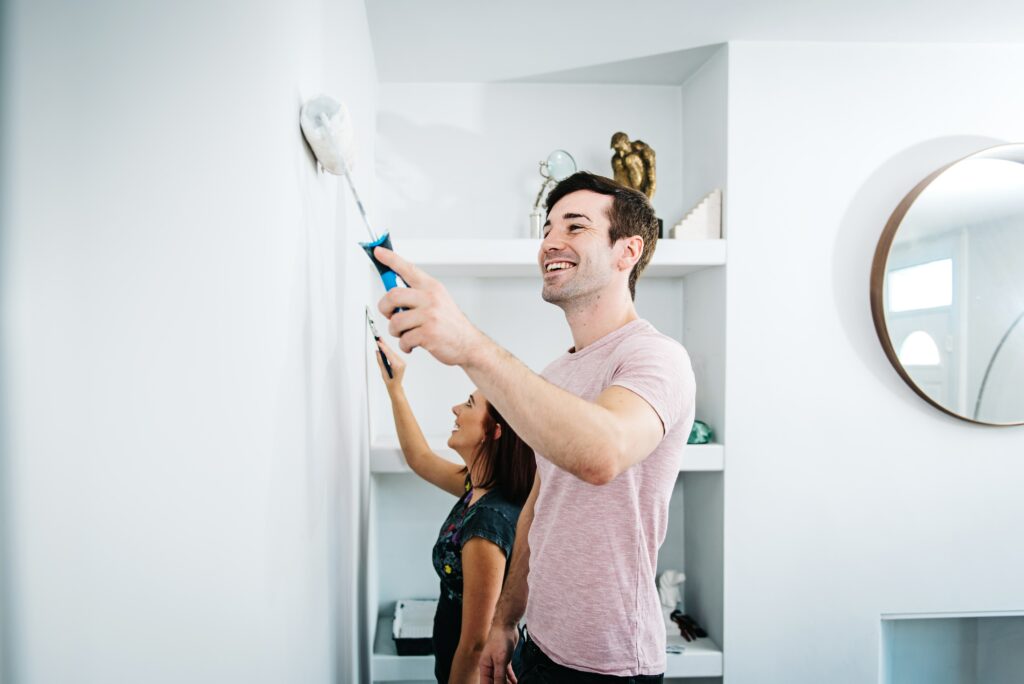With all the time we have spent at home, it is little wonder so many of us are looking to change our décor. But where to start? Quite often a simple colour change is all that is required to give our home a lift. In this article we give some great painting tips that will soon have your redecorating like a professional!
First things first, preparation!
To achieve a beautifully smooth paint finish, you will need beautifully smooth surfaces. Whether this means removing wallpaper that has creases or bubbles, or prepping walls and woodwork with a sander or perhaps you need to fill in a few dinks and notches. Your paint finish will only be smooth if you start with a smooth and clean area. Invest in good quality sandpaper or consider hiring a sander, good preparation is the key to a professional looking finish.

Choosing the right paint
The majority of paint sold in UK decorator and DIY stores is water based, oil-based paint will often give you a more vivid colour and is great for wet areas like bathrooms and kitchens. You will also need to consider which finish you want, will it be a glossy sheen, a matte or an eggshell. Feeling a bit lost at sea? Don’t worry this superb article from Elle Décor will help you to decide which type of paint you need based on your use, personal preferences and finish required.
Choosing your colour scheme
Choosing your paint colour is not an easy task. There are so many factors to consider, try to avoid buying paint without seeing what it will look like in the room you want to use it in. Paint colours will look very different under the electric lights in your local DIY centre than they will in the natural light or soft yellow lamplight of your room. We strongly recommend using tester posts to help you choose. This inexpensive method involves painting different shades of your chosen colour on a pre-prepared area of wall, make sure you view the results in daylight and at night as the appearance of colour differs as the light changes. If this method isn’t for you then why not turn to a virtual solution to help you choose? Try out Crown’s MyRoomPainter App, this free to download app uses real pictures of your room and shows you what they will look like redecorated in your colour variations.
The right tools
Now you know what paint you want to use; it is time to make sure you have all the right tools. By far the best paint finish is achieved with a roller or paint pad, make sure you have at least one for each colour you are going to use, unless you want to spend a couple of days waiting for washed rollers or pads to dry. It is also a good idea to have a pole for high areas like your ceilings. Next you will need brushes, a good quality angled brush is recommended for cutting in. To help you make sure you have everything you are going to need here is a sample list:
- Rollers, trays and extension pole
- Brushes for cutting in
- Decorators tape or masking tape, especially useful for feature walls and for protecting sockets
- A ladder for reaching higher parts of your wall
- Good quality dust sheets
- A damp sponge – too quickly catch any spills or blots
Painting
Finally, we are ready to start painting! Cutting in; don’t be tempted to do all the cutting in first and then roller, if the cutting in paint dries before you get a chance to roller it in you may end up with a noticeable difference – a frame! Load your cutting in paint brush and gently tap it against the side of the paint tin to knock off excess paint. Start your brush a short way away from the cutting in area and then drag your brush up to the line to establish your edge. Once you have an area to fill it is time to start rollering. Pour paint into your roller tray and push your roller through the paint and lift it to ensure it spins freely, if your roller merely rocks back and forth then it is unevenly loaded, so repeat the process to ensure a good even coating.
Start your roller action in the area you have cut in and go as close to the edge as you can to ensure you have the same rollered finish. When rollering use a “W” motion rather than a fully horizontal or vertical motion. This will give you a lovely even distribution and will avoid lighter/darker patches.
When you have completed the first coat of paint, leave it to dry before starting your second coat. Check your paint tin for dry times, these are usually around 2 hours but do vary so it is worth checking. Repeat the process above for your second coat and make sure you remove all decorators tape that is protecting the sockets and surfaces whilst the paint is still wet!
And there we have it, our top painting tips. We hope you found this article useful, why not head over to our social media platforms and show us how you did? (Twitter, Facebook and Instagram)






